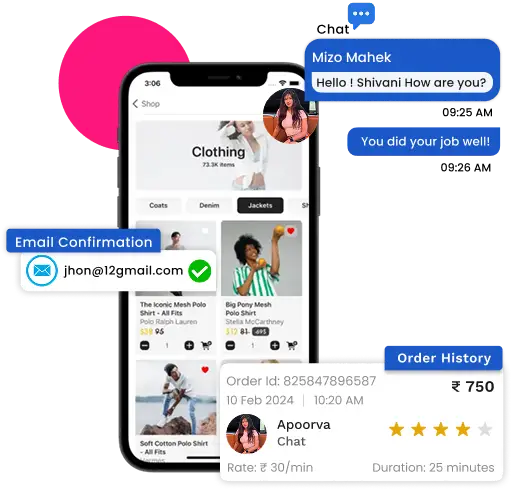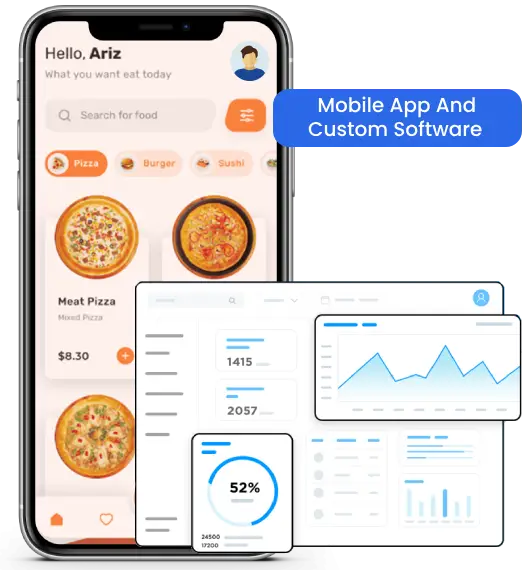Online shopping has revolutionized retail by offering unmatched convenience, yet it also introduces challenges for both brands and consumers. Traditional product images and descriptions often fail to convey an item’s true essence, leaving shoppers uncertain about size, fit, or appearance. Augmented Reality (AR) addresses this by blending virtual elements with the real world, enabling interactive, lifelike product experiences. Imagine previewing a sofa in your living room or virtually trying on sunglasses. Such features can eliminate doubts, boost confidence, and enhance customer satisfaction. Integrating AR product visualization into ecommerce platforms has become essential, offering a strategic advantage in a competitive market. This blog delves into the fundamentals of AR in product visualization, its key benefits, real-world applications, and emerging trends shaping this transformative technology.
Understanding Augmented Reality (AR) in Product Visualization
Augmented Reality enhances real-world environments by overlaying digital content, which users can interact with through devices like smartphones, tablets, or AR headsets. AR product visualization for ecommerce enables consumers to explore three-dimensional models of products as if they were physically present. The interaction allows users to see every detail, adjust angles, and understand dimensions in their own context, clearly improving over flat images or even videos.
Creating an AR experience involves several technical components such as capturing high-fidelity 3D scans or models of products and using AR engines to detect real-world surfaces and lighting conditions. These elements work together to provide a seamless and believable visualization that reacts naturally to user movements and environments. Advances in AR technologies and their growing accessibility make delivering these immersive experiences possible without requiring customers to purchase additional hardware, creating a direct link between product imagination and reality.
Key Benefits of Using Augmented Reality for Product Visualization
Augmented Reality (AR) is changing how customers explore products online by offering immersive, realistic views that bring digital shopping closer to real life. It improves product understanding, builds trust, and boosts engagement, creating a more satisfying buying experience. Here are the key benefits AR adds to product visualization for retailers and brands.

Enhanced Product Understanding
Visualizing products in 3D allows customers to perceive intricate details such as size, shape, texture, and color variations with remarkable clarity. The immersive view reduces misunderstandings that often occur with static images, enabling buyers to feel confident that what they see truly matches what they will receive. As a result, decisions become more informed and satisfying.
Reduced Return Rates
Displaying products virtually in the buyer’s actual environment minimizes surprises after delivery. When customers experience a realistic preview of how an item fits or looks, their expectations align more closely with reality. Accuracy reduces the chances of dissatisfaction and product returns, helping retailers save on costly logistics, restocking, and customer service challenges.
Increased Customer Confidence
Interactive AR experiences build trust by allowing shoppers to inspect products thoroughly before purchasing. Users can rotate, zoom, and place items virtually, removing uncertainty. Hands-on exploration fosters assurance in the product’s quality and suitability, which translates to higher satisfaction levels and fosters long-term brand loyalty through positive buying experiences.
Higher Engagement and Time Spent
Augmented Reality transforms shopping from a passive act into an interactive adventure, captivating users for longer periods. The playful nature of AR encourages customers to experiment with different product options and settings, increasing their time spent within the app or website. More engagement typically correlates with improved conversion rates and a greater likelihood of multiple purchases.
Competitive Differentiation
Brands that integrate AR technology position themselves as forward-thinking innovators in an overcrowded market. Offering AR capabilities attracts early adopters and tech enthusiasts who seek fresh, engaging shopping experiences. The advantage helps companies stand out from competitors, creating a unique selling proposition that appeals to modern consumers and enhances overall market presence.
Opportunities for Personalization
Augmented Reality combined with artificial intelligence enables dynamic customization tailored to individual customer preferences. Technology can adjust product visualizations, recommend options, or highlight features based on user behavior and past purchases. Personalized AR journeys resonate more deeply with customers, enhancing satisfaction and increasing the chances of conversion by offering unique, relevant experiences.
Enhancing Customer Engagement with AR Experiences
Shifting ecommerce from passive browsing to interactive exploration represents a paradigm change in customer engagement. Virtual try-ons and product placements empower users to test multiple options with a simple tap or gesture, replicating the tactile feedback of physical stores. Such immersive experiences fuel curiosity and can significantly increase average session duration.
Social sharing features integrated with AR create viral marketing opportunities. Enthusiastic users often post their AR interactions on social media, generating organic buzz and expanding brand visibility. Gamification elements tied to AR such as scavenger hunts or customization challenges can also deepen user involvement, creating memorable experiences that resonate beyond a single purchase.
Moreover, AR-driven tutorials and product walkthroughs educate users on features and benefits, turning ecommerce apps into both shopping platforms and learning hubs. This interactive education nurtures stronger emotional connections between customers and brands, fostering loyalty and repeat business.
Real-World Applications of AR Product Visualization
Augmented Reality transforms how customers experience products online by blending virtual images with real-world environments. The technology offers clear, interactive previews that help buyers make smarter decisions. Many industries use AR to boost customer engagement and confidence. Below are some key examples of how AR product visualization enhances shopping across different sectors.

Furniture and Home Decor
Visualizing furniture within a customer’s actual living space helps assess style, size, and placement without visiting physical stores. AR-enabled applications let users virtually arrange and customize rooms, experimenting with different designs and layouts. Immersive experiences show how pieces fit with your decor, boosting buyer confidence and reducing uncertainty.
Fashion and Accessories
Virtual try-ons for items like sunglasses, watches, or jewelry allow shoppers to instantly see how products look and fit. The technology mimics in-store fitting rooms, offering convenience and reducing hesitation when buying fashion items online. Providing realistic previews decreases return rates and improves the overall shopping experience, bridging the gap between digital and physical retail.
Beauty and Cosmetics
AR filters enable customers to experiment with makeup products like lipstick shades or eye shadow styles virtually. This interactive trial personalizes the buying journey, allowing users to test different looks before committing. Such experiences eliminate much of the guesswork, making it easier to find the right product and increasing customer satisfaction and confidence in their purchase.
Automotive Industry
Potential car buyers use AR to explore vehicle interiors, customize colors, and test different features without physically visiting a showroom. This immersive experience showcases numerous options without requiring dealers to maintain large inventories. AR tools streamline the sales process, improve customer engagement, and help buyers make informed decisions, boosting efficiency in automotive retail.
Electronics and Gadgets
Customers often hesitate when purchasing new tech due to concerns about size, compatibility, or aesthetics. AR product visualization for ecommerce allows users to see how devices like smartphones or smart speakers fit within their existing setups. Such realistic previews reduce doubts, helping buyers feel confident that their new gadgets will meet expectations and fit seamlessly into their environment.
Future Trends in Augmented Reality for Product Visualization
Rapid progress in AR hardware and software points toward even more immersive ecommerce experiences ahead. Lightweight AR glasses may replace handheld devices, freeing users to explore products in real space with hands unencumbered. Enhanced AI integration will enable AR platforms to learn user preferences dynamically, offering highly personalized product recommendations and adjustments.
Moreover, cloud-based AR content delivery promises accelerated loading times and real-time product updates, ensuring customers always see the latest models and features. 5G adoption will further improve AR app responsiveness, enabling smooth, high-fidelity visuals even on the go.
Emerging social commerce trends will integrate AR into live shopping, where influencers and sellers showcase products augmented in real-time while viewers interact instantly. Such innovations will reshape ecommerce into a fully immersive and interactive ecosystem.
Summing Up Everything
Augmented Reality product visualization revolutionizes ecommerce by providing rich, interactive experiences that transform how consumers connect with products. This technology bridges the gap between online convenience and in-person confidence, reducing guesswork and encouraging smarter purchase decisions. Businesses enjoy more engagement, fewer returns, stronger loyalty, and a distinct competitive advantage. Embracing AR becomes essential for ecommerce companies aiming to lead the future of retail.
At Dreamer Technoland, we specialize in seamlessly integrating ar product visualization for ecommerce apps, crafting customized AR product visualization solutions that truly connect with your audience. We use progressive technology to ensure smooth, intuitive user experiences designed to boost conversions and foster long-term customer loyalty. Our services include a dedicated project manager for clear communication and a 3-month free post-launch support period to ensure your app runs flawlessly. Partnering with us means embracing innovation through reliable, scalable, and future-ready ecommerce app development that drives meaningful business growth.
Related Articles to Ecommerce App Development
- How to Increase Your E-Store’s Revenue?
- 15 Best Ways to Speed Up Your Ecommerce Site
- Voice Commerce & Social Shopping: Building the Next Gen E‑commerce App
- Role of Ecommerce Mobile Apps in Shaping Modern Retail Strategies
- 10 Things to Consider When Building an Ecommerce Website
- What Are the Different Types of Ecommerce Applications?
- Top 5 Technologies for Building Ecommerce Platforms
- Customer Support AI Chatbot Solution for Ecommerce







